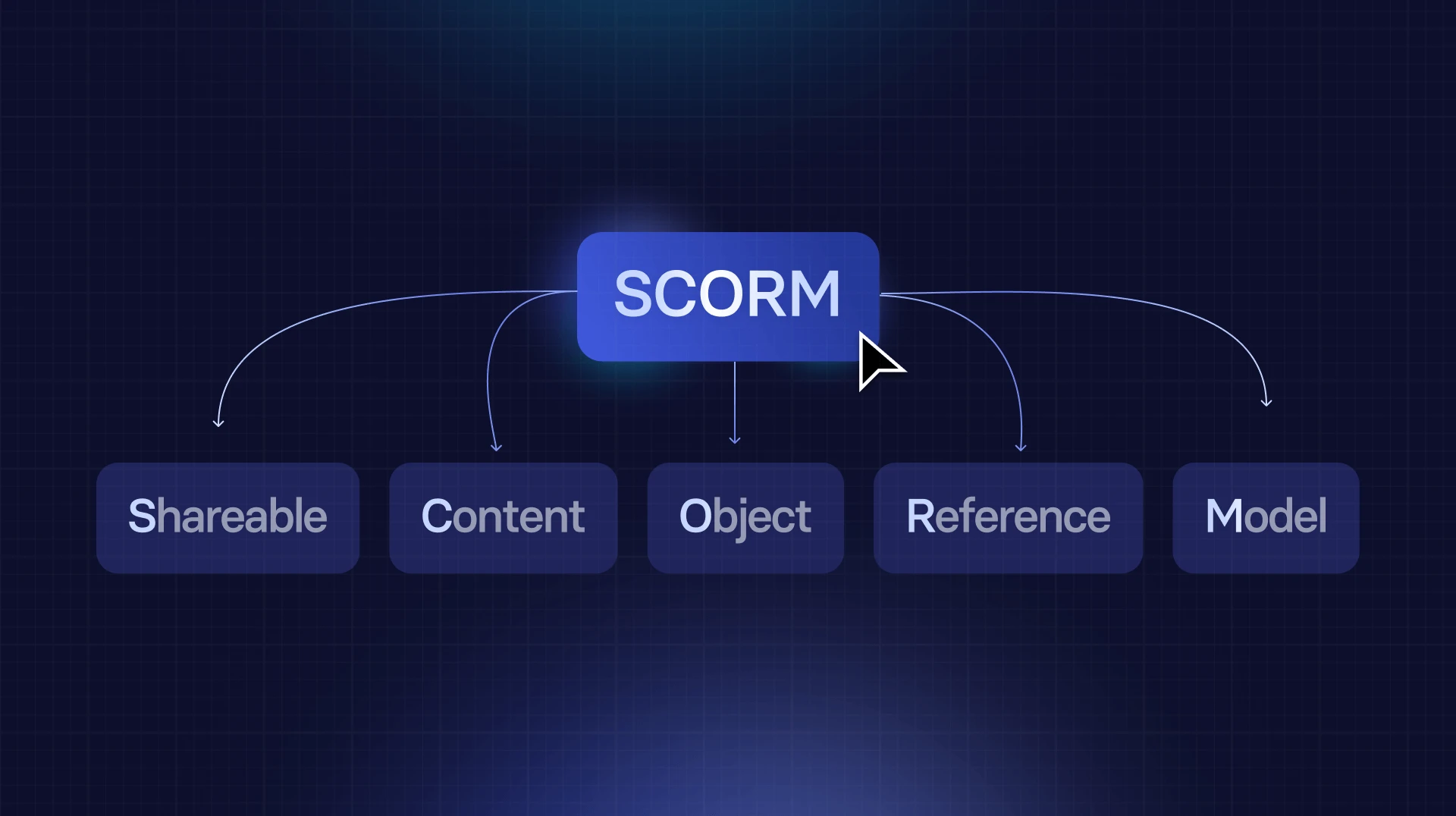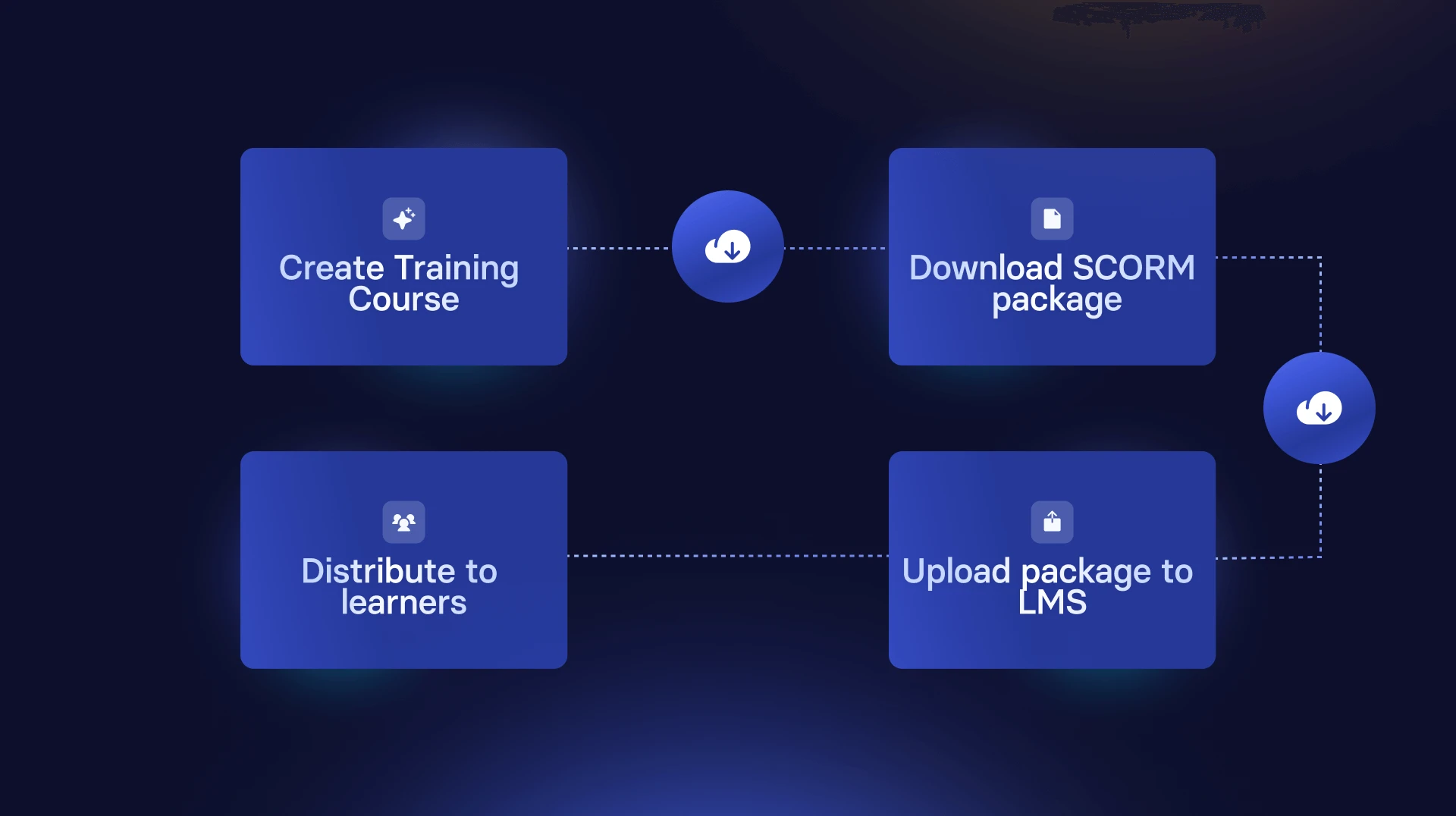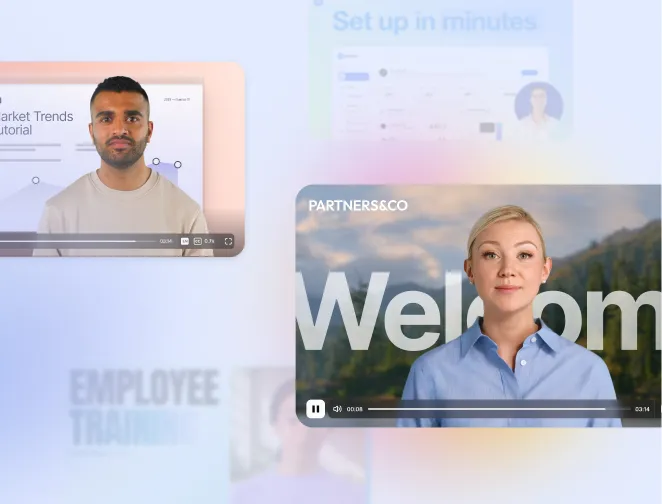
Create AI videos with 230+ avatars in 140+ languages.
SCORM is the universal standard that makes eLearning content compatible with any major Learning Management System (LMS).
Here’s a quick guide to help you understand how it all works.
💬 Keep in mind that the benefits of SCORM are rooted in technical compatibility between platforms and user tracking NOT performance. It can track completions and scores, but it can’t measure understanding, behavior change, or engagement.
What is SCORM?
SCORM is a framework of specifications that define how eLearning content communicates with LMSs. It stands for "Sharable Content Object Reference Model," but simply put, it's a standard that ensures your training content works seamlessly across any Learning Management System (LMS). If you're a learning and development professional, SCORM makes your life easier by allowing you to easily upload, track, and update your training content without technical headaches.
Think of SCORM as a "universal plug" for eLearning content. It's a set of technical standards that make sure any course you create can be used on any SCORM-compatible LMS.
When you build or buy eLearning content, SCORM ensures it "plays well" with whatever platform you use. This means you don't have to worry about compatibility issues between your courses and your LMS.

SCORM works through three core components:
- Content packaging (a ZIP file with a manifest that tells your LMS what's inside)
- Run-time communication (a JavaScript API that tracks learner data like scores and progress)
- Sequencing (rules that control how learners move through modules).
This standardization is why a course created in one tool can launch seamlessly in any SCORM-compliant LMS.
Developed by the Advanced Distributed Learning (ADL) Initiative of the U.S. Department of Defense, SCORM has been the backbone of eLearning interoperability for over two decades.
Its proven reliability and widespread adoption make it the go-to standard for organizations that want stable, scalable training delivery.
Why SCORM matters to you:
If you create training materials, SCORM makes it easy to:
- Upload Content: Seamlessly add your eLearning content to any SCORM-compliant LMS.
- Update Courses: Update your courses in one click, and they'll automatically update everywhere they're published.
- Track Learners' Progress: Monitor learners' progress, scores, and completion status directly through your LMS.
{{cta-section data-type="1" data-heading="Create Training Videos with Synthesia" data-body="Join over 1M+ users today and save time, reduce costs, and boost learner engagement with AI-powered videos in 140+ languages."}}
SCORM 1.2 vs. SCORM 2004: Which should you choose?
One of the biggest sources of confusion I encounter is choosing between SCORM versions. Here's what you need to know:
*In regulated industries like pharma or finance, the ability to separate ‘completion’ from ‘success’ in SCORM 2004 is essential for audit trails and compliance records.
Choose SCORM 1.2 if you need universal compatibility across older LMS platforms.
Choose SCORM 2004 if your LMS supports it and you need detailed quiz analytics or want to separately track completion and success (this is particularly important for compliance reporting).
3 steps to get started with SCORM
SCORM is a powerful tool for creating and managing eLearning content. Here's a quick overview of the essential steps to get started:
- Choose an authoring tool. Select a SCORM-compliant authoring tool like Articulate Storyline, Adobe Captivate, or Synthesia to create your eLearning content.
- Select a SCORM-compliant LMS. Choose an LMS that supports SCORM, such as Moodle or LearnUpon, and offers robust tracking, ease of use, and mobile access.
- Create your first SCORM package. Build your course, set completion criteria, export it as a SCORM package, and upload it to your LMS. Always test the package in SCORM Cloud first to ensure smooth tracking and playback.

8 key benefits of using SCORM for effective eLearning
1. Ensures universal compatibility across LMS platforms
SCORM content can be used on any compliant LMS, ensuring seamless access for all users and eliminating compatibility issues. Whether you're switching LMS platforms or sharing content across multiple systems, SCORM-compliant courses work without a hitch.
2. Efficient tracking & reporting
SCORM allows you to track learner progress, course completion, and quiz scores directly from your LMS dashboard. This provides detailed insights into how learners engage with your content and how effective your training programs are.
Here is what you can track with a SCORM course:
- Completion Status: Tracks if the learner has finished the course (e.g., "completed" or "incomplete").
- Pass/Fail Status: Records whether the learner has passed or failed based on assessments.
- Score: Captures quiz or test scores, usually as a numerical value.
- Time Spent: Tracks how much time the learner spends in the course or individual modules.
- Interactions: Monitors quiz answers, interactions, and activity responses within the course.
- Mastery Score: Indicates the passing score required to complete the course.
3. Saves time & reduces costs with standardization
By using SCORM standards, you reduce the need for creating platform-specific content. This allows you to quickly update and repurpose training materials, ultimately saving time and reducing costs associated with custom content development.
4. Enhances accessibility for all learners
SCORM supports the creation of content that meets accessibility standards, such as WCAG 2.0, making eLearning inclusive for all learners, including those with disabilities. Synthesia’s text-to-speech and closed captioning features make it easier to meet accessibility standards natively within SCORM modules.
5. Enables personalized learning paths
SCORM allows you to create adaptive learning experiences tailored to individual learner needs. By tracking progress, preferences, and performance, you can provide customized content pathways that adapt to each learner's pace and style.
6. Supports bite-sized learning with microlearning
SCORM facilitates the creation and distribution of short, focused learning modules, known as microlearning. This allows learners to access quick, targeted lessons that are easy to consume and perfect for those with limited time or attention.
7. Boosts engagement through gamification
By integrating gamification elements like points, badges, and leaderboards, SCORM can transform static content into interactive experiences. This motivates learners, encourages competition, and enhances engagement, making the learning experience more fun and effective.
8. Simplifies content updates and maintenance
Traditional SCORM packages require you to re-export and re-upload to your LMS every time you make a change. This is a time-consuming process that's particularly painful when managing multiple courses or frequent updates.
Modern solutions like Synthesia's SCORM export embed a dynamic player, so when you update your video content, the changes automatically reflect in your LMS without needing to regenerate or re-import the SCORM package. This drastically reduces administrative overhead and helps maintain version control in compliance-heavy environments.
SCORM vs. newer standards (xAPI and cmi5)
While SCORM remains the industry standard with 62% of businesses using it in their LMS (source), newer standards like xAPI (Tin Can API) and cmi5 are emerging.
xAPI offers more flexible tracking beyond LMS environments and can capture learning that happens in the flow of work.
However, SCORM's broad LMS compatibility and proven reliability make it the practical choice for most organizations today. If you're in a highly regulated industry requiring detailed compliance tracking, SCORM 2004 remains your best bet.
What else do you need to know?
After implementing SCORM across hundreds of enterprise deployments, I've learned these considerations make the difference between smooth rollouts and painful troubleshooting sessions:
- Pick the right authoring tool: Choose a SCORM-compliant tool like Articulate Storyline or Synthesia that fits your content style and complexity.
- Check LMS compatibility: Make sure your LMS supports SCORM 1.2 or SCORM 2004 and offers good tracking features.
- Choose your SCORM version: Decide if you need SCORM 1.2 for basic tracking or SCORM 2004 for more advanced features.
- Plan your content: Structure your courses in a way that makes them easy to update and reuse with SCORM's modular approach.
- Consider time and costs: Keep in mind the cost of tools and the time needed for setup.
- Ensure accessibility: Make sure your content is accessible to everyone by following standards like WCAG 2.0.
- Leverage multilingual capabilities: If you're training global teams, look for solutions that support multiple languages within a single SCORM package. With Synthesia's multilingual video player, learners can select their preferred language within the same SCORM package.
By thinking through these points, you'll set yourself up for success with SCORM and create more effective, easy-to-manage eLearning programs.
{{cta-section data-type="1" data-heading="Create Training Videos with Synthesia" data-body="Join over 1M+ users today and save time, reduce costs, and boost learner engagement with AI-powered videos in 140+ languages."}}
About the author
Strategic Advisor
Kevin Alster
Kevin Alster is a Strategic Advisor at Synthesia, where he helps global enterprises apply generative AI to improve learning, communication, and organizational performance. His work focuses on translating emerging technology into practical business solutions that scale.He brings over a decade of experience in education, learning design, and media innovation, having developed enterprise programs for organizations such as General Assembly, The School of The New York Times, and Sotheby’s Institute of Art. Kevin combines creative thinking with structured problem-solving to help companies build the capabilities they need to adapt and grow.

Frequently asked questions
What does SCORM stand for?
SCORM stands for Sharable Content Object Reference Model. It's a set of technical standards that ensures your eLearning content works seamlessly across different Learning Management Systems (LMS), acting like a universal plug that makes your training materials compatible with any SCORM-compliant platform.
Think of SCORM as the common language between your training content and your LMS. When you create or purchase eLearning materials that follow SCORM standards, you can upload them to any compatible LMS without worrying about reformatting or compatibility issues, saving you time and ensuring your training works everywhere it needs to.
Which LMSs use SCORM?
Most major Learning Management Systems support SCORM, including popular platforms like Moodle, LearnUpon, TalentLMS, Cornerstone OnDemand, and Docebo. The widespread adoption of SCORM means that whether you're using an enterprise-grade system or a more affordable solution for smaller teams, your SCORM-compliant content will work smoothly.
This universal compatibility is one of SCORM's biggest advantages. You can create your training content once and deploy it across multiple LMS platforms, or easily switch between systems without having to rebuild your courses from scratch, making SCORM the practical choice for organizations that want flexibility in their learning technology stack.
How does Synthesia keep SCORM courses up to date without re-uploading?
Synthesia uses a dynamic player embedded within the SCORM package, which means when you update your video content in Synthesia, those changes automatically reflect in your LMS without needing to regenerate or re-import the SCORM package. This eliminates the traditional hassle of re-exporting and re-uploading SCORM files every time you need to make a change.
This approach drastically reduces administrative overhead, especially when managing multiple courses or frequent updates. For example, if you discover an error in a compliance video that's deployed across 50 courses in your LMS, you simply fix the video once in Synthesia, and all instances update automatically, saving hours of manual work while maintaining version control in compliance-heavy environments.
Can I deliver one SCORM package in multiple languages with Synthesia?
Yes, Synthesia's multilingual video player allows learners to select their preferred language within the same SCORM package. This means you can create one course that serves your entire global team, rather than managing separate SCORM packages for each language.
This capability is particularly valuable for organizations training international teams, as it simplifies content management while ensuring everyone receives training in their preferred language. By consolidating multiple language versions into a single SCORM package, you reduce the complexity of course deployment and maintenance while providing a better learning experience for diverse audiences.
How do I test a SCORM package before uploading it to my LMS?
The best way to test a SCORM package is using SCORM Cloud, a free validation tool that lets you upload and preview your course exactly as it will appear in your LMS. This testing step helps you verify that all tracking features work correctly, content displays properly, and navigation functions as intended before deploying to your production environment.
Testing in SCORM Cloud can save hours of troubleshooting later by catching common issues like missing manifest files, incorrect completion criteria, or tracking problems. Once your package passes testing in SCORM Cloud, you can confidently upload it to your LMS knowing it will work smoothly for your learners.











